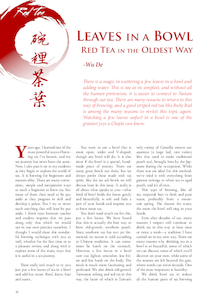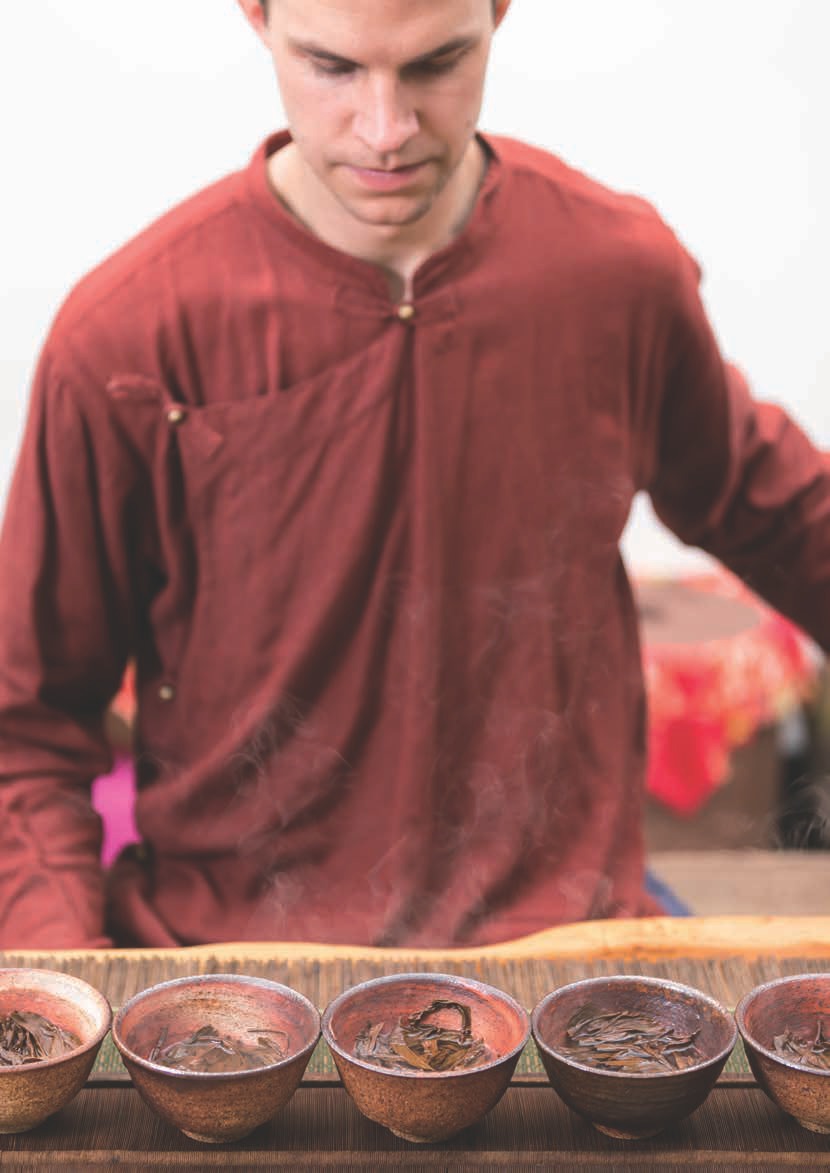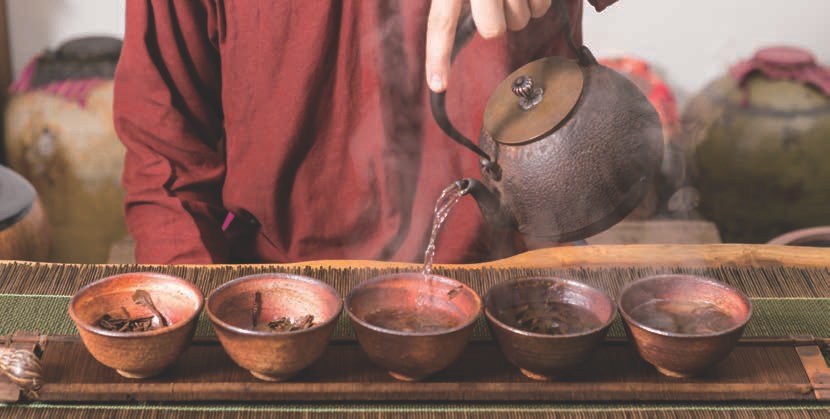
 |
|
Years ago, I learned one of the most powerful ways of brewing tea I've known, and my tea journey has never been the same. Now, I also pass it on to my students as they begin to explore the world of tea. It is brewing for beginners and masters alike. There are many convenient, simple and inexpensive ways to teach a beginner to brew tea, but many of them then need to be put aside as they progress in skill and develop a palate. But I try to never teach anything that will later be put aside. I think trust between teacher and student requires that we pass along only that which we would use in our own practice ourselves. I thought I would share this wonderful brewing technique with you as well, whether for the first time or as a pleasant review, and along with it explore some of the many ways that it is useful in a tea journey.
There really isn't much to it: you just put a few leaves of tea in a bowl and add hot water. Bowl, leaves, heat and water...
You want to use a bowl that is more open, wider and V-shaped, though any bowl will do. It is also nicer if the bowl is a special, handmade piece of pottery. There are many great bowls out there, but we always prefer those made with tea spirit, like the tea ash bowls we will discuss later in this issue. It really is all about what speaks to you - what kind of bowl holds the leaves gently and beautifully, is soft and feels a part of your hands and inspires you to brew more tea.
You don't need much tea for this, just a few leaves. We have found that this is actually the best way to brew old-growth, newborn puerh. Since newborn tea has not yet fermented, its nature is cold according to Chinese medicine. It can sometimes be harsh on the stomach. However, a few leaves in a bowl turn out lighter, smoother, less bitter and less harsh on the body. The result is much more fascinating and profound. We also drink old-growth Taiwanese oolong and red tea in this way, the latter of which is Taiwan's only variety of Camellia sinensis var. assamica (a large leaf, tree variety like that used to make traditional puerh tea), brought here by the Japanese during the occupation. While these teas are ideal for this method, we've tried it with everything from greener oolongs to white tea to aged puerh, and it's all nice.
This type of brewing, like all tea, responds best to fresh and pure water, preferably from a mountain spring. The cleaner the water, the more the bowl will sing in your hands.

Even after decades of tea, many masters I respect still continue to drink tea in this way at least once or twice a week - a tradition I have carried on in my own way. There are many reasons why drinking tea in a bowl is so beautiful, some of which we can discuss; some of which you'll discover on your own; while some of the reasons are left beyond the gate, where words can never intrude. One of the most important is humility.
We drink bowl tea to reduce all the human parts of tea brewing to almost nothing. There are no, or very few parameters: Simply adjust the amount of leaves and water temperature - or don't and enjoy the tea however it turns out. In this way, we let go of all pretensions. There is no longer any quality in the tea brewing, no comparative mind - no better or worse. A lot of skill and mastery often leads to snobbery. Then we miss the chance to connect with Nature, ourselves and each other through tea. In drinking bowl tea, and minimizing the human role in tea, we can return to just leaves and water, where the true dialogue begins.
Try drinking a bowl of leaves and water, simply and beyond all refinement. Returning to the simplest and oldest way of making tea is often very profound. Through drinking tea in this way you may awaken your own insights, beyond these few I share freely now.
Putting a handful of leaves in a bowl and adding hot water is the oldest of tea brewing methods, dating back thousands and thousands of years. In antediluvian forests, pristine in verdure, sages exchanged wisdom over such steaming bowls. They would find wild tea trees and process the tea on the spot, withering, roasting and drying it as they talked or sat in silent meditation. No doubt they also had pouches and jars of aged teas lying around for special occasions, when distant masters chanced to visit - when certain astrological and cosmological conjunctions happened, making the time ideal for powerful tea and deeper meditation, or even to celebrate seasonal changes...
Using crystal mountain water, boiled simply over charcoal, they would cover the leaves in water and in energy from their Qi Gong and meditation - passing more than just tea and water to the traveler or student, but a part of themselves. Tea has always been a communication of the Tao precisely because it goes beyond words and the concepts they engender, and there is a truer representation of my wisdom in the tea I serve you than in a thousand books or lectures. "The tea doesn't lie," as they say. You can't make your gongfu, your skill in tea, any more than what it is with any amount of embellishment, fancy words and descriptions: the tea will tell the tale.
When you are drinking tea in this way, you continue this ancient tradition. Close your eyes and imagine the craggy folds of an ancient mountain chain, dancing like a saffroned scroll painting. In billowing silk robes you sit beneath a wizened old tea tree, by some rocks and a stream. You can hear the "wind sowing the pines" as the kettle boils away. The master sticks his hand into an old pouch, more cracked and worn than his hoary face. His gentle hands reach across and flutter the leaves into your bowl. He holds the kettle for a moment or two, until it whispers to hush... And then in slow, gentle circles, he covers your bowl in steam - swirling the leaves around in more circles as they open...
古 老 簡 單 真 實
不 完 美 本 質 明 亮
It is important that we don't get caught up in all the pretension that can accumulate as you learn about tea. Unfortunately, some people become snobby about their tea and lose the ability to enjoy the tea without all the perfect accoutrements, expensive pots, kettles and jars. The Japanese tea ceremony was often criticized by monks and spiritualists alike, since many practitioners lost the true spirit of tea over time and turned it into a chauvinistic obsession based on collecting expensive teaware and tea and showing off to others. Rikyu tried to right this by incorporating local, simple raku pottery and natural decoration in a simple aesthetic. Today also many people use tea to promote themselves, and get lost in knowing more or having more than others.
This isn't the only way we brew tea at the Center; it is great to explore all the nuances of different kinds of teaware and gongfu methodology. But more important than any kind of teaware, pouring skill or brewing technique is respect - one of master Rikyu's four essential virtues of tea (the others being harmony, purity and tranquility). Don't lose yourself in connoisseurship, thinking you are better than others or know more about tea. I would much rather drink gas-station-quality oolong with a humble monk in the mountains, pure of heart, than expensive tea with someone using his tea and knowledge to promote himself.

By returning to the simplest of tea-brewing parameters a few times a week, we can effectively wipe the slate clean. All of our affectation is gone. There are no better cups, jars or pots; no need to pour in certain directions or from certain heights; no better or worse - just leaves in water.
The discriminating mind can often ruin tea, analyzing and criticizing what should be enjoyed, embraced and absorbed into the body and spirit. There is a time for working towards bringing the best out of teas through skill, and a time for returning to softness when the human element and all our posturing is put aside in favor of the simplicity of Nature, which since ancient times has attracted people of spirit to tea.
I have my students follow only this method for the first months that they are learning about tea, so that when they move on to learning about all the different kinds of teaware and tea, skills and techniques, they do so from a simple base. And returning to that foundation each week, they never forget their roots in the "beginner's mind," free of all the ego that ruins tea more than any bad water ever could.
The Japanese tea aesthetic was long ago called "wabi," which in part means the simplicity we discussed above. Wabi is also about enhancing and then rejoicing in the imperfection of true life. It means that the moon partially covered by clouds offers more to the imagination than the radiant full moon, and more adequately represents the formless and form as one. As poet Leonard Cohen put it, "There is a crack, a crack in everything. That's how the light gets in."
Wabi is a difficult aesthetic to master, as it is hard to contrive imperfection that is natural. It has to be spontaneous and flow out of Nature, which is also often so beautiful precisely because it is illogical and disorderly, and the mind cannot organize it. It is no wonder that such a rational society as ours would prefer the ordered, hedged garden to the forest the sages of old rejoiced in.
Of course, you can find a tea bowl made with wabi aesthetic and this may enhance your experience. There is nothing like holding a master-crafted bowl of tea, exploring all the nuances created by the kiln and seemingly or truly unintended by the artist.
Also, we often get a clearer representation of a tea's quality brewing it this way, and it may involve a fault of some kind. Rather than criticizing or even accepting the issues, why not embrace them as an aspect of the tea before you - this very moment of your life as it is, and as it ever shall be? There is an even more profound relaxation and a deeper, more rewarding attitude towards life when you can step beyond mere acceptance of the imperfect moment to an actual participation in and enjoyment of the experience, despite whatever perceived defects you may notice.
These days, a greater and more understanding dialogue between human and Nature is needed above all else. All of our personal and social problems stem, in essence, from the fact that we have ignored this conversation - a subtle whisper still heard if you quiet the mind or walk in the forest where the noise of the city is far away and the river's voice more audible.

Over centuries, our analytic, rational minds have been developed to an extraordinary degree, creating such wonderful advancements in technology and science, like this very computer I now type on. But this exclusive focus on the rational mind has also meant the loss of another, more ancient kind of intelligence: the feeling of being a part of this world.
Lost in the rational voice that narrates our lives, many people feel completely disassociated from each other, Nature and the world. An intelligence and wisdom born of a connection with Nature was self-evident to ancient peoples. Through this connection, they understood inarticulate aspects of Nature that are completely lost to us today - the names and ways of the star constellations, the role of the seasons, rivers and mountains in our lives - the way a lifespan was measured in "winters" for example - and all the communication between Spirit, animal and our nature that we no longer understand... And in our solipsism, ignoring Nature to explore our own desires and satisfaction, we have polluted the Earth; and only now that the warning voice has reached a cataclysmic volume is humankind once again beginning to hear and understand what has been sacrificed in the name of technological development.
Obviously, our social problems aren't about a lack of science or information. We have so much information that huge computers can't store it all, and you couldn't learn even a fraction of it in a lifetime. Wisdom is what is needed. It isn't new technology or information, but the proper application of the sciences and awakened, aware living that is the key to our prosperity, both personally and as a species.
When you drink tea from a bowl, there is an even greater connection to the Nature within the leaves. Lighter brews often reveal the deepest qualities of a tea, connecting you to the sun, moon and mountain that all worked in conjunction to form these leaves. When you then cover them in mountain spring water, the effect is powerful indeed. If you stop all other activity and focus on the bowl before you, the voice of Nature often returns, louder than ever before. You find yourself connected and complete, a part of the process that began with a seedling gathering sun, water and mountain to it as it grew into a tree, sprouted a crown of glorious leaves, which are now culminating in this very warmth and energy coursing through you as you drink...

Brewing tea simply in a bowl allows for a kind of clarity of the senses. Between sips, you can hold the bowl and close your eyes, allowing the warmth to flow through your arms, just as the inner warmth spreads through your chest. With all the room in the world, the leaves open up gloriously in the bowl and are a delight to behold, which is one more reason why this method works so well with old-growth teas.
There is a sense of openness to the bowl and leaves other brewing methods cannot compare to, connecting the tea more clearly to the room and people around it. This connection, more than anything else, is why my first such session will remain one of the most memorable tea sessions of my entire life, even though that first 'leaves in a bowl' session was simple green tea in a rustic, dark Rabbit's Fur bowl; and even though I've also drunk many rarer and brighter teas since.
When you drink tea this way there is no question of quality, or evaluation of any kind. There is no need to record your impressions internally or communicate them externally. The tea ceremony is stripped down to its most basic elements: leaves and water, self and no-self.
In such a space, you are free to be yourself. Many times, the conversation naturally winds down and you and your guests smile at each other one last time before drifting off into contentment, contemplation or meditation. This quietude is paramount in living a healthy life in accord with the Dao, balancing stillness and activity and acting from depth and with meaning, when the time is right. After all, what is important cannot be expressed as well in words as it can in the direct transmission of something so intimate as liquor we ingest into our bodies, prepared by the hands of the master - not I, but the true master behind your face.
The essence of a tea is beyond its flavor or aroma to the energy deep within the veins of the leaf, just as the essence of the tea ceremony is beyond the tea or teaware. Master Rikyu once told a student, "imagine your life without tea and if it is any different than it is now, you have yet to truly understand Cha Dao."
If tea becomes pretentious and snobby, the essence is lost. Anyone can learn about tea by reading and traveling to tea-growing regions. It is the Dao that is the more powerful and lasting part of a tea session, not the tea. And actually, though it may sound paradoxical (or even downright zany-Zenny illogical), transcending the tea is the true tea. So it's either all about the tea or not at all, depending on how you look at it.
The tea bowl before you is a gateway to yourself, and beyond that the Nature and the flow of energy through this universe. And it is often easier to transcend the tea when the process is simpler and closer to the essential Nature that produced the tea in the first place.
